Posted by Anita on 05.14.09 6:26 AM
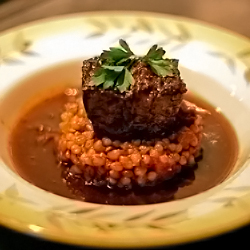 Despite our enduring love for our nieces and pint-sized friends, this blog will never feature the sort of recipes that usually pass for kid-friendly meals. With high-octane cocktails, labor-intensive recipes, and frequent bouts of profanity, no sane reader would ever mistake me for a mommy blogger. And yet, one of the best food books I’ve read in quite some time — one I actually forked over cash to buy — is Hungry Monkey: A Food-Loving Father’s Quest to Raise an Adventurous Eater. A title that’s shelved not with the cookbooks, but in the heretofore unexplored Baby & Toddler section of my local bookstore.
Despite our enduring love for our nieces and pint-sized friends, this blog will never feature the sort of recipes that usually pass for kid-friendly meals. With high-octane cocktails, labor-intensive recipes, and frequent bouts of profanity, no sane reader would ever mistake me for a mommy blogger. And yet, one of the best food books I’ve read in quite some time — one I actually forked over cash to buy — is Hungry Monkey: A Food-Loving Father’s Quest to Raise an Adventurous Eater. A title that’s shelved not with the cookbooks, but in the heretofore unexplored Baby & Toddler section of my local bookstore.
I doubt Hungry Monkey would have found its way to our house if we weren’t already friends with the book’s author, Matthew Amster-Burton, and his daughter Iris. But that surely would have been my loss, because once I picked it up, I couldn’t stop reading. Or laughing. Matthew’s a pretty funny guy, something you may already know if you read his blog, Roots & Grubs, or his witty writings on Culinate, Gourmet.com, or pretty much anywhere else you go for clever, thoughtful food writing these days. And even if you couldn’t give a fig for the intricacies of raising a little fresser, you can’t help but be drawn in by Matthew’s no-nonsense ideas about food.
Now, in the interest of full disclosure, I think it’s only fair to admit that I’m friends not only with Matthew, his wife Laurie, and little Iris, but also with grandma Judy, and many of the other characters in the book — Tea, Shauna, Molly, and the gang — so reading a chapter is like old home week for me. Some of my favorite memories from our Seattle days involve the dinner parties we used to throw. Every New Year’s Day, we’d make an enormous pot of cassoulet and invite our friends to polish it off; the Amster-Burtons were among the 50 or so food-obsessed friends who came to the second-annual fête.
I don’t remember much else from that day, but I do remember Iris — who had just turned one — sitting on our kitchen floor and calmly polishing off an adult-sized plate of braised pork, beans, and duck confit. Reading the book, I was tickled that Matthew remembered, too: The cassoulet-gobbling tale is but one of dozens of spot-on anecdotes he uses to illustrate his theories. (In this case, the point is: “Stew is the ultimate in baby food. It’s easy to make. It’s easy to eat: you don’t even need teeth.”)
But aside from personal affection, Matthew’s stories of cooking for Iris are universal, whether you’re a parent, a proud aunt, or even kid-agnostic. In a way, my feelings about Hungry Monkey are similar to Matthew’s own enthusiasm for his daughter’s culinary education:
“I was gung-ho about sharing our food with Iris for the same reason people share food with each other everywhere: it’s fun. It was the first opportunity for Iris and me to share an experience and enjoy it for the same reasons. I mean, I liked playing peek-a-boo (I called it “peekytoe”) because it made Iris laugh, but it’s not like it’s something Laurie and I played before Iris was born — or, at least, I wouldn’t admit to it. But I like enchiladas. Iris likes enchiladas. We can agree on enchiladas.”
On the surface, I may not have a lot in common with a stay-at-home dad. But our mutual love of food — and a fondness for belly laughs — makes Hungry Monkey worth a read, even if you have no experience with the tribulations of breastfeeding, or coaxing a toddler to the dinner table. With the exception of a couple of purees, there’s hardly a recipe in the book that looks or tastes like kid chow. Last winter, Cameron and I tested a dozen or so of the recipes during the book’s development, and we’ll personally vouch for Matthew’s stacked enchiladas, Cornish pasties, and bibimbap, not to mention a recipe for carnitas that’s so quick and simple we didn’t believe it would work. (It did, deliciously.)
If you need further convincing, plan to pop by one of Matthew’s readings in the Bay Area the week of May 24 (check the schedule here). Photographic evidence indicates that Hungry Monkey is even more hilarious when read aloud by its author.
If you can’t get to one of Matthew’s book-signings, there’s still a chance to have your own brush with fame: I’ve got an extra copy of the book — there is some payoff for being a recipe-tester! — and it just so happens that Matthew will be visiting us on his swing through town. So, if you’d like to win an autographed copy of Hungry Monkey, leave a comment below telling us about your favorite food when you were little. Next weekend, I’ll pick a comment at random and get in touch with the lucky winner to ask how they’d like the book inscribed.
In the meantime, here’s a little proof that not all kid-friendly food has to look like stewed prunes and taste like mush.
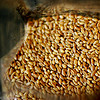
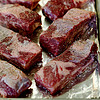
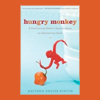
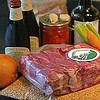
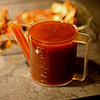
Beer-Braised Short Ribs with Wheat Berries
– from Hungry Monkey by Matthew Amster-Burton, reprinted with permission
3 to 4 pounds beef short ribs (flanken or English-style)
salt and pepper
3 tablespoons olive oil
2 cloves garlic, thinly sliced
1 large onion, diced
1 carrot, peeled and diced
1 celery stalk, diced
1 cup wheat berries (see note)
2 bottles (2-1/4 cups) porter-style beer
1 cup canned crushed tomatoes, not drained
1-1/2 cups chicken stock
2 tablespoons minced parsley
Preheat oven to 450°F.
Season the ribs liberally with salt and pepper and place them on a foil-lined baking sheet (bone-side down if you’re using English style ribs). Roast 45 minutes or until they’re nicely browned and have rendered plenty of fat. Reduce oven temperature to 275°F.
While the ribs are roasting, heat the olive oil in a Dutch oven or other large pot over medium heat. Add the garlic, onion, carrot, and celery. Cook until vegetables are limp but not browned, 5 to 10 minutes.
Add the wheat berries, beer, tomatoes, and chicken stock, and stir to mix. Add the browned ribs, raise the heat to medium-high, and cover. When the pot is boiling, transfer it to the oven (you did remember to turn it down to 275°F, right?). Braise for 2-1/2 to 3 hours, or until meat is very tender. Season with additional salt and pepper to taste.
If serving immediately, remove the meat and strain the sauce, then skim off the fat with a spoon or gravy separator. Otherwise, cool to room temperature and refrigerate everything together, skimming off the solidified fat before reheating. Give each person one or two ribs (remove the bones before serving if you like), a ladleful of wheat berries and sauce, and a sprinkling of parsley.
Note: Wheat berries are available in the bulk section at any health food store. Mine has sometimes managed to run out, so I’ve substituted pearl barley to good effect. Hard or soft wheat berries will work. For another variation, substitute French green lentils for the wheat berries.
cookbooks, meat, other blogs, recipes
26 Comments »




Posted by Anita on 05.12.09 5:34 PM
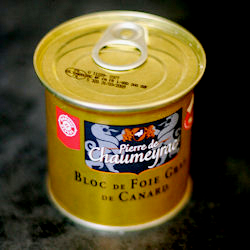 Bill Andronico
Bill Andronico
Andronico’s Markets Inc.
1109 Washington Avenue
Albany, CA 94706
Dear Mr. Andronico:
I have been a long-time shopper at your Irving Street store in San Francisco. Although I no longer purchase meat at the supermarket — preferring to buy my meat and eggs directly from farmers who make a point of their humane and ethical practices — I have always been very impressed by the knowledge and skill of your butchers in the past. Which is why I am stunned to read about your ill-informed, reactive policy regarding foie gras sales.
I don’t generally eat foie gras myself — I don’t care for its richness, nor its cost — but from rather extensive reading on the subject, I think it’s quite plausible that the “cruelty” of its production is overrated. On the other hand, I fully believe that standard, everyday conditions for commercial hens, pigs, cows, and other factory-farmed animals are grossly inhumane by any realistic measure.
If you and your company truly cared about animal welfare, you would stop selling battery-hen eggs and feedlot pork. Intensive factory farming is far more cruel — and thousands of times more pervasive — than the process of “force feeding” geese and ducks.
I suggest you do some additional homework about the realities of what goes into the meat, eggs, and dairy you sell before zeroing in on such an easy knee-jerk target. (The movie Food, Inc., which opens next month, might be a good starting point.) Otherwise, you run the risk of looking like a publicity-hungry hypocrite.
Bay Area, meat, shopping
9 Comments »




Posted by Anita on 02.09.09 10:52 PM
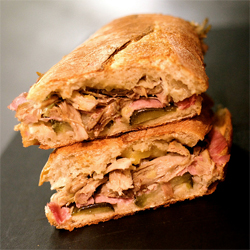 I keep teasing you about the pig roast, and — I’m sorry — this isn’t going to be that post, either. I’d like to say that it was such an epic event that I’m still wrapping my brain around it, or maybe that I am still trying to choose among the fabulous photos our friends took to illustrate the post.
I keep teasing you about the pig roast, and — I’m sorry — this isn’t going to be that post, either. I’d like to say that it was such an epic event that I’m still wrapping my brain around it, or maybe that I am still trying to choose among the fabulous photos our friends took to illustrate the post.
In truth, my only excuse is that we had a rather… dramatic weekend, including one night that didn’t end until 4:30 the next morning — for entirely not-fun reasons. We’re all fine now, but all the drama meant there wasn’t a lot of time for rest, reflection, or anything resembling creativity, either in the kitchen or at the computer.
Luckily, there was a freezer full of pig-roast leftovers, which is like money in the bank as far as I’m concerned. Even with sleep-deprived brains, we knew well enough to thaw out a bag of pulled pork to feed our weary bones. On Sunday morning, Cameron pulled together another one of his famous hash-and-eggs brunches with part of the meat; later on, we dug up a couple of Acme grinder rolls and made Cubanos with the rest.
These Cuban-style pressed sandwiches — roast pork, ham, cheese, pickles, and mustard, all smooshed together into a crunchy-soft-chewy miracle — are just the sort of thing we want to eat when we need a little cheering up. If you happen to have some cabbage and carrots and onions around, I can vouch that Cubanos are pretty tasty with a quick slaw; all you need is mayo, cider vinegar, salt and pepper. Otherwise, a cup of black-bean soup would not be out of place, nor would a handful of banana chips.
 If you don’t have a freezer full of pulled pork (pobrecito!) you can substitute leftover roast chicken, or even leave out the roast meat completely. To compensate, add a little extra ham and cheese and you’ve got the makings of another venerable Cuban sandwich: the Medianoche — named, so they say, for the midnight hours when many are consumed, to fuel up for another round of late-night dancing or drinking.
If you don’t have a freezer full of pulled pork (pobrecito!) you can substitute leftover roast chicken, or even leave out the roast meat completely. To compensate, add a little extra ham and cheese and you’ve got the makings of another venerable Cuban sandwich: the Medianoche — named, so they say, for the midnight hours when many are consumed, to fuel up for another round of late-night dancing or drinking.
You may read otherwise elsewhere, but you don’t need any special equipment to make a Cubano — though I am sure a panini press would be handy, if you happen to have one. Once you have all the ingredients on hand, a Cubano is simple to make, and it’s comfort food of the highest order. And really, couldn’t you use a little coddling?
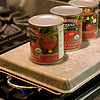
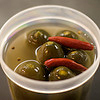

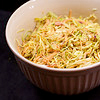
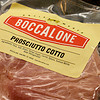
Cuban Sandwiches
– adapted from Kitchen Sense
2 rustic sandwich rolls, about 6″ (or half a wide-ish baguette)
2-4T mustard
2T mayonnaise (optional)
1 whole kosher dill pickle
4 slices ham
4oz roast pork (or chicken), shredded
2 slices mild cheese (such as Jack or a mild Swiss)
Preheat a large cast-iron skillet or a griddle over medium heat.
Slice the pickle lengthwise into four pieces, and set aside. Cut the rolls lengthwise, leaving the back side attached as a hinge. Open the rolls up and spread a light layer of mustard on the inside bottom. If using mayonnaise (which I recommend unless your pork is very juicy), spread an even layer on the inside top half of each roll.
For each sandwich: Place two pickle slices on top of the mustard, then top with a slice of ham and half of the pulled pork. Top with a slice of cheese, and close up the sandwich.
Place the sandwiches on the preheated skillet or griddle, and press down with a wide spatula. Top the sandwiches with a cookie sheet or a second skillet, and weight down (big tomato cans work well). Cook for 4 minutes, pressing down firmly on the weights every minute or so.
Using hotpads, remove the cookie sheet. Turn the sandwiches over and replace the sheet and weights, again pressing down firmly. The liquid from the pickles and ham will sizzle a little bit; this is a good sign. Cook for another 4 to 5 minutes, until the top of the roll is crispy and the cheese is melted. Remove from the pan and cut each sandwich in half; serve immediately while hot.
Dark Days challenge, locavore, meat, recipes
6 Comments »




Posted by Anita on 01.28.09 9:16 PM
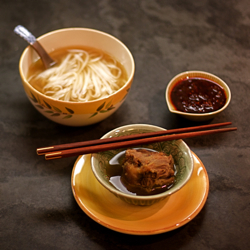 We usually consume our oxtails in an Italian-style ragu. But with Chinese New Year upon us — and the Year of the Ox, at that — it seemed like an Asian preparation would be more appropriate.
We usually consume our oxtails in an Italian-style ragu. But with Chinese New Year upon us — and the Year of the Ox, at that — it seemed like an Asian preparation would be more appropriate.
In the world of Chinese oxtail recipes, the options generally boil down to either a hearty braise with root vegetables, or a simple long-simmered soup. In the latter, the meat is simmered for hours until it’s meltingly tender, then served in two parts, much like a French pot-au-feu: a platter of meat with a piquant dipping sauce, and a bowl of clear broth to fill the belly and provide a respite from the spicy, meaty main.
Usually, rice would accompany the meat, but in the spirit of the New Year celebration, we opted to add noodles — which signify long life — to the broth. If you’re not so keen on eating out of two separate bowls, you can pull the meat off the oxtails and stir it in with the noodles and broth, then serve with the sauce on the side for each diner to stir in as she chooses.

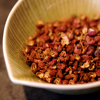



Sichuan Oxtail Soup
– adapted from Land of Plenty and Classic Food of China
2-1/2 to 3 pounds of meaty oxtail
2 chicken drumsticks (or any two pieces of dark meat)
3- to 4-inch piece of fresh ginger, unpeeled
2 tsp whole Szechuan peppercorns
1/2 cup Shaoxing wine (or medium-dry sherry), divided use
6-8 oz dry rice noodles (your choice of width)
salt to taste
– Sauce
1T peanut oil
1/4 cup Sichuan-style chili bean paste
2 tsp dark soy sauce
2 tsp sesame oil
Soak the oxtail pieces in cold water for 30 minutes, then discard the soaking water.
In a large, heavy-bottomed pan, bring 3 quarts of water to a boil. Add the oxtail and chicken, and return to a boil. Skim off any foam that floats to the top, then reduce heat to maintain a steady simmer, stirring occasionally and adding water as needed to keep the oxtails mostly submerged.
Smash the ginger with the back of a knife or other heavy object. Add it to the pan along with the peppercorns and 1/4 cup of the Shaoxing wine. Partially cover the pan, and simmer for at least 3 hours.
Meanwhile, prepare the sauce: Heat the peanut oil in a wok or skillet until very hot but not smoking. Add the chili bean paste, and stir fry until the oil is deep red and the sauce is fragrant. Pour the sauce into a heatproof bowl; when cooled, add the soy sauce and sesame oil.
At the end of the simmering time, the oxtail should be very tender and the meat will pull away from the bone but not completely separate from it. Remove the oxtails to a plate, discarding the simmered-out chicken parts. Pick off any peppercorns that stick to the oxtails and discard. Drain the broth through a fine seive, discarding the peppercorns and ginger, and return the clear dark broth to the pot. You should have about 6-8 cups of soup at this point; add additional cold water if needed, or simmer down the broth. Once you have the proper quantity, add the remaining 1/4 cup Shaoxing wine, then salt the broth to taste. Return the oxtails to the pan and gently reheat until very hot. (If you want to serve the soup in one bowl, pick the meat from the bones before returning it to the broth.)
Meanwhile, prepare the rice noodles according to package directions. (Usually this involves soaking the noodles in boiling water, as opposed to simmering them.) When cooked, divide the noodles among 4 soup bowls, then ladle the hot broth over them. Serve the oxtails in a separate large bowl or tureen, moistened with a bit of the broth, and allow each diner to choose their piece, eating it out of a rice bowl by pulling the meat off the bone and dipping it in the sauce to taste.
holidays & occasions, meat, recipes
10 Comments »




Posted by Anita on 01.26.09 2:25 PM
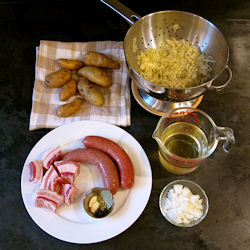 Along with our annual cassoulet, one of our favorite mid-winter traditions is simmering up a big pot of choucroute garnie — literally, garnished sauerkraut — in the Alsatian tradition. (Leave it to the French to come up with the brilliant idea of taking a delicious-but-homely pile of fermented cabbage and garnishing it with a pile of pork products.)
Along with our annual cassoulet, one of our favorite mid-winter traditions is simmering up a big pot of choucroute garnie — literally, garnished sauerkraut — in the Alsatian tradition. (Leave it to the French to come up with the brilliant idea of taking a delicious-but-homely pile of fermented cabbage and garnishing it with a pile of pork products.)
Every French traiteur worth his salted pork products keeps a giant crock of choucroute cru on hand, and it’s to this raw mixture that cooks will add their preferred mix of meats, wine, and seasonings. Here in the States, we have to look a little harder for the good stuff. At a minimum, start with refrigerated kraut — often found in bags or tubs near the chilled pickles at larger supermarkets. Even better would be to find a deli or artisan who sells fresh-fermented ‘kraut by the pint or the pound. However you source it, though, you want to start with crispy, bright shreds, not a mushy mash of greenish sog.
 Once you’ve found the appropriate vegetable matter, you need to consider your garnishes. Nearly every choucroute recipe calls for white wine, potatoes, bay leaf, and juniper berries; meaty additions typically include multiple kinds of sausage, as well as either ham or pork belly. Variations include apples, slices of smoked pork loin, and even duck confit. Like most home-style dishes, the exact ingredients are a matter of regional and personal preference; it’s almost impossible to go wrong.
Once you’ve found the appropriate vegetable matter, you need to consider your garnishes. Nearly every choucroute recipe calls for white wine, potatoes, bay leaf, and juniper berries; meaty additions typically include multiple kinds of sausage, as well as either ham or pork belly. Variations include apples, slices of smoked pork loin, and even duck confit. Like most home-style dishes, the exact ingredients are a matter of regional and personal preference; it’s almost impossible to go wrong.
There’s really only one problem with traditional choucroute: Its size. Don’t get me wrong: It’s a lovely thing to make when you’re feeding a crowd, and like so many peasant foods, leftovers are possibly even better than the original meal. But for a midweek supper, the usual cocotte trés grande is a bit of overkill. But if you find yourself with a some sauerkraut hanging around — perhaps after making a flight of Reuben sandwiches? — you can make a smaller, simpler version with a small bag of easily-sourced market goodies.
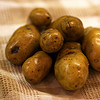

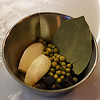
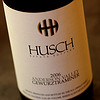
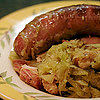
Petite Choucroute
– loosely adapted from Anthony Bourdain’s Les Halles Cookbook
1 pound good-quality sauerkraut (we like Alexander Valley Gourmet)
4 fingerling potatoes
2T lard or bacon fat
1 small onion, diced
5 juniper berries
2 small garlic cloves
1 small bay leaf
1/2 tsp coriander seed
1/2 bottle (1.5 cups) dry-but-fruity white wine, such as Riesling
2 sausages, approximately 1/2 pound (* see note)
8oz pancetta (or slab bacon, pork belly, etc.), cut into 2-inch chunks
Rinse the sauerkraut in cold water and drain well. Boil the potatoes until slightly firm; cut in half and set aside.
Heat the pork fat in a medium saucepan over moderate heat. Saute the onion until softened. Add the sauerkraut, aromatics, and wine, plus salt and pepper to taste. Cover and bring to a simmer. Add the pancetta; recover and simmer over lowest heat for 90 minutes. Place the potatoes on top of the choucroute, cut side down, and tuck into the simmering liquid. Put the sausages on top of the choucroute; cover again and simmer gently until the potatoes and sausage are warmed through.
To serve, spoon the choucroute into two warmed, shallow bowls, dividing the meats and potatoes evenly. Serve with spicy mustard on the site.
—
* We typically use Fatted Calf knockwurst to complement Boccalone pancetta. Feel free to improvise with the sausages you’re able to find locally, or even to choose different meats. Bear in mind you want some contrast between the flavors, but that they should play well together. If you’re using slab bacon, try a sausage that isn’t smoked or heavily salted, like a mild bockwurst. Other winning combos include garlic sausages with duck confit (add the latter at the end instead of simmering it), or ham hocks with boudin blanc. If you’re using unsmoked sausages, you’ll need to poach them before adding to the choucroute for the final simmer.
Dark Days challenge, locavore, meat, recipes
5 Comments »




Posted by Anita on 01.19.09 7:54 AM
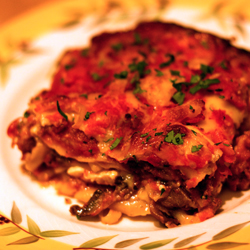 It must happen to everyone: That moment when you lose all ambition for trying new recipes and just fall back on the tried and true, the comfort foods that make your heart and belly happy, with a minimum of fuss.
It must happen to everyone: That moment when you lose all ambition for trying new recipes and just fall back on the tried and true, the comfort foods that make your heart and belly happy, with a minimum of fuss.
Last week, Cameron came down with a doozy of a cold. It wasn’t really terrible, in the symptoms department, but it seemed to go on forever and ever. It wasn’t the end of the world, but it was just annoying enough to keep him home, working at the dining room table and sipping mug after mug of lemon and honey. In much the same way, taking care of the house and the dogs all on my own isn’t really traumatic, but it is time-comsuming… and the thought of coming home and spending an hour or more in the kitchen — especially all alone — wasn’t terribly appealing. I looked for recipes that I could prep, preferrably in the morning or the night before, and then pop into the oven when I got home. And, of course, they had to appeal to the palate of a guy who had a head full of winter weather.
 Unfortunately for you, and for my narrative, the two all-local meals we ate last week were both repeats: My mom’s famous meatloaf — with Dirty Girl romanesco and baked Little’s potatoes on the side — and a thrown-together lasagna using home-canned tomatoes, locally made cheeses and fresh pasta.
Unfortunately for you, and for my narrative, the two all-local meals we ate last week were both repeats: My mom’s famous meatloaf — with Dirty Girl romanesco and baked Little’s potatoes on the side — and a thrown-together lasagna using home-canned tomatoes, locally made cheeses and fresh pasta.
For both of these meals, I took a slightly different route than my usual, mixing ground pork from our meat CSA with spices to make bulk sausage — home-grown sage for the meatloaf’s breakfast sausage, and home-grown fennel seed for the lasagna’s Italian sausage. Of course, the texture’s no match against real home-ground sausage, but in a highly flavored dish like lasagne, the difference is fairly negligible. And the taste? Comforting and hearty, just like always.
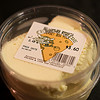
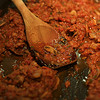

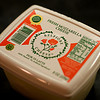

Quick Italian Sausage
1 pound ground pork (at least 30% fat)
1T kosher salt
1T fennel seed
1-1/2 tsp coarse black pepper
3/4 tsp sugar
2-3T ice cold water
Mix all ingredients together well. Fry a small test patty to taste for salt and seasoning, and adjust as needed. Let sit overnight, if possible, to allow flavors to blend.
Dark Days challenge, Italian, locavore, meat, recipes
5 Comments »




Posted by Anita on 01.12.09 7:22 PM
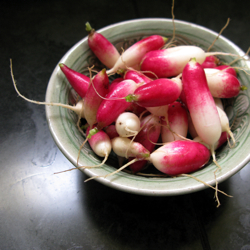 After two-plus weeks in London, we knew it was going to be difficult to get back to the grind, and the cold, grey weather here in San Francisco wasn’t doing anything to help us get over our jetlag.
After two-plus weeks in London, we knew it was going to be difficult to get back to the grind, and the cold, grey weather here in San Francisco wasn’t doing anything to help us get over our jetlag.
In a rare fit of travel wisdom, I’d planned our return for Saturday, to give us time to do little things like food shopping and laundry before heading back to work. But we arrived home far too late to get to our usual market at the Ferry Plaza, and the idea of trudging through a brightly lit supermarket didn’t seem the slightest bit appealing.
So after a fortifying Sunday morning breakfast, we headed across the Golden Gate bridge, in search of the Marin Civic Center farmers market. Even though this market isn’t much further from home than the downtown Berkeley market, we’d never checked it out. What we found was pretty impressive: A good number of stalls — maybe close to 100 — with a lot of variety, even in the middle of winter.
 We certainly had no problem finding meat. Marin Sun Farms was there, as were the Prather Ranch boys and Devil’s Gulch Ranch — a name we’ve seen on menus, but never bought; they don’t sell at the SF markets. By the time we arrived, all they had left was a big five-pound pork shoulder roast. We hemmed and hawed, then decided that we could make a big batch of carnitas and save the leftovers for a later meal. A vendor from San Luis Obispo — technically outside our challenge radius, but we fudged it — was selling avocados, and a bakery from Sacramento had corn tortillas; we’d made the right decision.
We certainly had no problem finding meat. Marin Sun Farms was there, as were the Prather Ranch boys and Devil’s Gulch Ranch — a name we’ve seen on menus, but never bought; they don’t sell at the SF markets. By the time we arrived, all they had left was a big five-pound pork shoulder roast. We hemmed and hawed, then decided that we could make a big batch of carnitas and save the leftovers for a later meal. A vendor from San Luis Obispo — technically outside our challenge radius, but we fudged it — was selling avocados, and a bakery from Sacramento had corn tortillas; we’d made the right decision.
We also picked up a pretty bone-in pork chop from Marin Sun, plus the usual assortment of vegetables and starches. Once we returned home, I popped the pork chop in my usual cider brine for a few hours. For our first Challenge meal of the week, we served it with mashed potatoes and a really nice chopped salad of romaine, avocado, radishes, carrots, and cucumbers, all tossed in a citrusy dressing and topped with grated dry Jack. (I was mimicking a salad I used to love ordering at Two before they went downhill, and I think I got pretty darned close.)
Every time I opened the fridge, that enormous pork shoulder was staring back at me. With a full week of evening commitments ahead, I quickly figured out that I’d bitten off more than I could chew; there just wasn’t time in our schedule for the full evening of patient simmering that carnitas requires. And with a slate of office projects piling up, there was no way I could work from home to coddle it.
I wondered aloud if the Crock-Pot might offer a solution, and Cameron agreed that it might be worth a try. “The worst thing that happens is you end up with pork stew.” A quick cruise around the Web didn’t really turn up much in the way of a trustworthy recipe, so I decided to wing it. I used our usual carnitas recipe, with a couple of changes: I left the meat in larger chunks to combat the tendency for everything to turn to mush. I also reduced the liquid — slow cookers retain a lot more moisture than even the best-sealed pots — and kicked up the brightness with a little citrus, to compensate for slow cooking’s flavor-dulling effect.
I’d popped the ingredients in the pot, then headed to the office, fully expecting to return home in about 8 hours to keep an eye on the tail end of the cooking process. Naturally, work dramas conspired against me, so it was nearly 12 hours later that I walked in the front door. A heavenly smell from the kitchen relieved some of my fears that I’d created a pile of overcooked, dry slop.
I shouldn’t have fretted. The part of the meat that wasn’t submerged got pretty toasty… an unexpected bonus. The rest of the meat was perfectly cooked, juicy and tender, with just enough connective tissue left to keep things together until you hit it with a fork.
In a traditional carnitas recipe, the braising liquid gets simmered down — with the meat in it — at the end of the cooking process; the meat gets nice and crispy in the fat that remains after the broth simmers away. To simulate this effect, we drained the juices and skimmed off the fat to sear the meat. And as a bonus, we have an ice-cube tray full of really yummy pork broth.

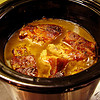
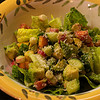
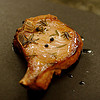

Crock-Pot Carnitas
4 pound boneless pork shoulder
1T whole cumin seed, lightly chopped or crushed
2 bay leaves
1 onion, quartered
1 cup rich pork or chicken stock
1 oz orange juice or Meyer lemon juice
salt, to taste
water, as needed
Cut the pork shoulder into large chunks, and sprinkle with the salt and cumin. Place in the Crock-Pot with the bay, onions, stock, and juice. Add enough water, if needed, to come halfway up the meat. Cover with lid, set pot on low, and cook for 10-12 hours, until meat is very tender.
Remove the meat from the pot and set aside in a warm place. Pour the cooking liquid into a fat separator, let settle, and then pour the defatted broth into a wide pan or baking dish to cool, reserving for another use. (Alternately, use a glass measuring cup and a turkey baster to separate the fat from the broth, or your usual fat-separating method.)
Heat a large skillet, and add enough of the skimmed carnitas fat to the pan to cover the surface well. Pull the meat apart, creating pieces approximately 1 inch long, and add to the pan once the fat is sizzling. Brown the meat until crispy on the outside, turning with tongs as needed. Remove each piece from the pan as it browns on all sides, keeping warm until ready to serve.
Serve with warm tortillas and your choice of condiments: salsa, chopped cilantro and onions, guacamole, sliced radishes, etc.
Dark Days challenge, farmers markets, locavore, meat, recipes
6 Comments »




Posted by Anita on 11.30.08 11:26 AM
 Apparently, I am not equipped to exist on 5 hours of sleep every night for an entire month, which is what happens when you try to hold down a job, tackle a little freelance work, keep a house in order, cook most meals at home, and blog every single night. But even though I failed at NaBloPoMo, I really did have a blast trying to keep my head above water. Despite the blog-silence, our week has been filled with all kinds of wonderful things to eat and drink… fodder for future posts, I promise, as we return to a slightly saner schedule in December.
Apparently, I am not equipped to exist on 5 hours of sleep every night for an entire month, which is what happens when you try to hold down a job, tackle a little freelance work, keep a house in order, cook most meals at home, and blog every single night. But even though I failed at NaBloPoMo, I really did have a blast trying to keep my head above water. Despite the blog-silence, our week has been filled with all kinds of wonderful things to eat and drink… fodder for future posts, I promise, as we return to a slightly saner schedule in December.
The highlight of our week — like many of yours, I suspect — was our big Thursday feast for Thanksgiving. This year, we managed to wiggle out of all of our family obligations, so it was just the two of us: No marshmallow-topped baked yams or gelatinous cranberry sauce (nor any of the other stuff neither of us likes) and no giant spreadsheet to track food miles. We still ate 100% local, but with a much smaller, simpler menu, we didn’t need to document with such precision.
I picked up our turkey — a burlap-wrapped 18-pounder from Napa’s Hudson Ranch, sold to us by Tayor at the Fatted Calf — at the Tuesday Berkeley Farmers Market. This squat little guy was so muscular we didn’t even need to truss the legs to keep them tight against the carcass. Although all we did was salt it the night before and slather it in butter, describing its taste sounds like a cliché: Moist and tender, yet full of deep poultry flavor. And the rich drippings made some of the most delicious gravy we’ve ever had.
 To go with the amazing turkey and gravy, we peeled and mashed many pounds of creamy La Ratte spuds from Mr. Little, mixed with butter from Spring Hill and Straus Family cream. Stuffing was the usual family recipe, with Fatted Calf bacon, Eatwell celery and parsley, Catalán onions, Acme bread, and our own home-grown sage and home-made chicken stock. There was corn from The Peach Farm — which I zipped and froze a few weeks back — and a bottle of Five Russians Pinot Noir from Sonoma. For dessert: Pumpkin pie made from local organic pumpkin, eggs, and dairy, in a crust of local flour (a blend of Eatwell and Giusto’s), Clover Organic butter, and Prather leaf-lard.
To go with the amazing turkey and gravy, we peeled and mashed many pounds of creamy La Ratte spuds from Mr. Little, mixed with butter from Spring Hill and Straus Family cream. Stuffing was the usual family recipe, with Fatted Calf bacon, Eatwell celery and parsley, Catalán onions, Acme bread, and our own home-grown sage and home-made chicken stock. There was corn from The Peach Farm — which I zipped and froze a few weeks back — and a bottle of Five Russians Pinot Noir from Sonoma. For dessert: Pumpkin pie made from local organic pumpkin, eggs, and dairy, in a crust of local flour (a blend of Eatwell and Giusto’s), Clover Organic butter, and Prather leaf-lard.
With only two of us to tackle a family-sized turkey, we cut off a whole breast, leg, and thigh, and vacuum-sealed them for the freezer; somewhere down the line there’s another round of turkey dinner (and leftovers!) in our future… what a way to stock up for winter!
The rest of our luxurious long weekend, we’ve spent tackling other Dark Days-related projects. Cameron’s been hard at work on building and filling our new raised beds, and we may even get a few starter crops in the ground before the new year. I’ve been pickling and preserving — a few quarts of chicken stock and turkey broth, some pickled jalapeños, and a batch of pub onions. After the canners were put away, I reorganized our freezers in preparation for laying down a few last supplies for the winter.
This week’s trip to the farmers market was pretty light, since we’ll mostly be eating an assortment of yummy bits and pieces from deep storage. Although a week of freezer fare may sound rather dreary, after four days of nonstop cooking and turkey leftovers, I’m really looking forward to a few meals where the hardest part is defrosting the main dish and making a big salad.
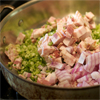


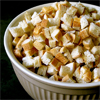
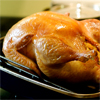
This year, I am especially thankful for:
– My wonderful husband, who takes care of me and our home with such obvious affection.
– Our family, who understand our need to take a break from the festivities now and then.
– Our social circle, whose hospitality and friendship keep us sane and happy.
– Our readers and blog pals, who encourage us and inspire us.
– Our amazing City, where we count ourselves lucky to live every day.
– Our region’s hard-working farmers and food artisans, who provide us with the world’s most amazing array of edibles.
Dark Days challenge, holidays & occasions, locavore, meat
6 Comments »




Posted by Anita on 08.24.08 6:08 PM
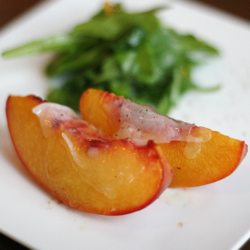 Aside from grinding and stuffing a few pounds of sausage now and then, curing meats is a task — much like beer-brewing and bread-baking — that I am more than happy to leave to the experts. Don’t get me wrong: I love getting up to my elbows in fatty meat and curing salts and aromatics. But when you have local artisans like Fatted Calf, even the most enviable meat-curing skills become obsolete.
Aside from grinding and stuffing a few pounds of sausage now and then, curing meats is a task — much like beer-brewing and bread-baking — that I am more than happy to leave to the experts. Don’t get me wrong: I love getting up to my elbows in fatty meat and curing salts and aromatics. But when you have local artisans like Fatted Calf, even the most enviable meat-curing skills become obsolete.
To say we’re big fans of the work that Taylor Boetticher, Toponia Miller, and the rest of the Fatted Calf crew are doing is a huge understatement. We’ve spent the last two years gleefully eating our way through their entire offering, and there’s barely a thing we’ve tried that didn’t make us squeal with delight. Their smoky bacon is heaven in a frying pan, their rind-on pancetta is nothing short of funky-fabulous. Their beef jerky is addictively awesome, and their pâtés and terrines are a slice of savory joy. Their sausages — especially the Toulouse and the andouille — are light-years better than anything we make at home.
So when we heard that Piccino — a jewelbox cafe/restaurant in Dogpatch, the next neighborhood over — was hosting a supper featuring Fatted Calf products, cooked jointly by Taylor and the Piccino crew, we reserved two slots as fast as our little fingers could email the RSVP.
I should add at this point that Cameron and I have mostly given up on these sorts of one-night foodie extravaganzas. It’s too easy to get your expectations set impossibly high, or to calibrate each bite to the fantastic sum of money you’ve spent. We went against our usual stance this week for two reasons: Piccino is precisely the kind of restaurant we love — a cozy neighborhood space with a short, ingredient-driven menu that actively supports local farmers and food artisans — and because we can’t get enough of Fatted Calf.
On the night of the meaty meal, we gathered on the sidewalks in front of Piccino’s corner doorway. Happy gaggles of diners shunned the interior and spread down each street, glasses of deep-pink rosé in hand as we savored a rare, warm San Francisco summer evening. We hung back for another reason, too: We weren’t sure how we would all fit into the small dining area. Eventually, we were called to the communal table, so we squeezed onto the banquette, tried not to knock elbows with our neighbors, and wondered just what we’d gotten ourselves into.
We needn’t have worried. By the time the second course (and third glass of wine) rolled around, we’d been utterly, completely won over. There were some service mishaps — one end of the table missed out on a pizza that somehow got misdelivered not once but three times — but these were forgivable, almost-funny oversights. We were chatting with our neighbors quite amiably by this point, companionably sharing platters of assorted charcuterie and a casuela full of lightly pickled, jewel-like vegetables.
 For the next course, we each got our own plates… a wise move, as I suspect that riots might have broken out otherwise. Who could be trusted to share a perfectly ripe Hamada Farms peach, draped with tissue-thin lardo, accessorized with a bitter-crisp salad of baby dandelion greens? (Hint: Not me.) Next up came an inspired riff on pork and beans: Shelling beans cooked to a toothsome creaminess, garnished with crisp-chewy pork rillons and melted Early Girl tomatoes.
For the next course, we each got our own plates… a wise move, as I suspect that riots might have broken out otherwise. Who could be trusted to share a perfectly ripe Hamada Farms peach, draped with tissue-thin lardo, accessorized with a bitter-crisp salad of baby dandelion greens? (Hint: Not me.) Next up came an inspired riff on pork and beans: Shelling beans cooked to a toothsome creaminess, garnished with crisp-chewy pork rillons and melted Early Girl tomatoes.
Then, the main course platters filled the table: unctuous smoked lamb; bowls of fregola with charred young onions and baby potatoes; marinated eggplant with roasted gypsy peppers and capers; golden beets with their own sauteed greens, tarragon, and ricotta salata; and an out-of-this-world mint chutney. After hours of joyful din, passed platters, copiously refilled glasses, and a bevvy of spontaneous toasts to the kitchen, we were struck dumb. Everyone, all down the table, sat nearly silent, in awe of the fabulous food.
We hardly had room for dessert, but we bravely soldiered on. Plates of figs in various stages of caramelization arrived, dolloped with sheep’s milk fromage blanc, decorated with strawberries, and accompanied by an almond tuile. We lingered in the candlelight, talking with new acquaintances and exchanging plans to run into one another at the market next weekend. When I looked at my watch, I was stunned to see it was nearly midnight: We’d passed 5 hours in a magical space that somehow seemed to have grown larger, filled with conversation, light, and laughter.
To me, the most amazing thing about the whole meal was that (with the exception of the fregola and the wines) everything we ate came from within our local foodshed. The lamb was grown on the same Napa homestead as the shelling beans, both brought to Taylor as part of an over-the-fence trade with a prolific neighbor. Like all of Piccino’s regular meals, the vegetables and fruits for the evening were sourced from local farmers; many of their names graced the menu.
Although this was a one-time event, we’re already looking forward to going back to Piccino often. (I’ve stopped in a few times for a glass of wine and a bite to eat after picking up my Mariquita mystery box, but I haven’t really tried a whole meal there. That’s going to change.) And, if you’re in the mood for an epic food evening like ours, check out the Piccino schedule; there’s another meat dinner scheduled with RoliRoti’s Thomas Odermatt in October, and a mushroom feast with Far West Fungi in November.


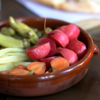
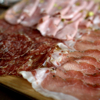

Piccino Café and Pizzeria
801 22nd Street
San Francisco, CA 94107
415/824-4224
Fatted Calf Charcuterie
Oxbow Public Market
644-C First Street
Napa, CA 94559
707/256-3684
– Also sells most products at:
Berkeley Farmer’s Market
Saturday, 10 to 3
Ferry Plaza Farmer’s Market
Saturday, 7:30 to 2
locavore, meat, Napa & Sonoma, One Local Summer, restaurants
10 Comments »




Posted by Anita on 08.17.08 4:00 PM
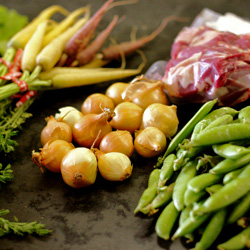 Compared with other parts of the country, most of the Bay Area’s food-growing regions benefit from amazingly temperate climates. Our summers here are so mild that we never really lose our early crops. We’re able to buy all those little springtime dainties — sugar-snap peas, baby carrots, and tiny onions — deep into August.
Compared with other parts of the country, most of the Bay Area’s food-growing regions benefit from amazingly temperate climates. Our summers here are so mild that we never really lose our early crops. We’re able to buy all those little springtime dainties — sugar-snap peas, baby carrots, and tiny onions — deep into August.
It’s a little joke of nature, of course, because the summer months in San Francisco feel like the worst parts of everyone else’s schizophrenic spring. You know that “in like a lion, out like a lamb” effect that people ascribe to March? Well, here we get it all in a single August weekend. Repeatedly.
For every warm and sunny Sunday where all you want is a summer supper of insalata caprese and a nibble of grilled chicken, there are twice as many foggy, grey Saturdays where something a little more substantial is in order. Not that we’re hauling out the cassoulet or anything, but our summertime cold snaps are so inevitable that we almost always plan a stew or braise each week, to haul out when the fog rolls in.
But even when the mercury dips down into the 40s, I have a hard time getting behind ultra-heavy dinners. The nights are still short, after all, and we’ve probably had at least a glimpse of sun during the day. So I prefer a compromise; a stew that’s almost spring-like, with a lighter air about it.
In France, you’d probably serve a lighter braise like the one we made this week in springtime, with a glass of rosé and a loaf of crusty bread. But, socked in by fog so dense we could barely see the neighbors’ yard, we opted for a pile of mashed heirloom potatoes and a half-bottle of local Syrah.
The good news is that the best is yet to come: The true beauty of San Francisco weather is our Indian Summer. When the rest of the world is gearing up for deep autumn, our farmers will still be pulling in corn, tomatoes, and all the other high-summer crops. But for now, while we slip on our sweaters, a stew will do.





Navarin Printanier — Braised Lamb with Young Vegetables
1 large thyme sprig
1 rosemary sprig
1 bay leaf
6 whole black peppercorns
2 pounds lamb stew meat
olive oil
1 small onion, small dice
3 cloves garlic, minced
1 cup dry white wine
2 cups beef stock
12 pearl onions
1/2 lb baby carrots, trimmed and scrubbed
1/2 lb sugar snap peas, trimmed
2 T unsalted butter (room temperature)
3 T all-purpose flour
Preheat oven to 300°F. Put the rosemary, thyme, bay leaf, and peppercorns in an infusing ball, or tie into a square of cheesecloth.
 Trim the stew meat of all excess fat, and cut into 2-inch pieces; season with salt and pepper. In a 4-quart pot, heat enough olive oil to coat the bottom of the pan, and brown meat in as many batches as needed to keep from crowding the pan. As each piece becomes well browned, remove it to a bowl with tongs or a slotted spoon. Continue with remaining meat, adding more oil as needed.
Trim the stew meat of all excess fat, and cut into 2-inch pieces; season with salt and pepper. In a 4-quart pot, heat enough olive oil to coat the bottom of the pan, and brown meat in as many batches as needed to keep from crowding the pan. As each piece becomes well browned, remove it to a bowl with tongs or a slotted spoon. Continue with remaining meat, adding more oil as needed.
After all meat is cooked and resting, add onions to the pan. Cook over medium heat until softened and beginning to color. Add minced garlic and continue to cook until onions are golden. Add the wine and the stock, scraping the bottom of the pan to loosen any browned bits. Return the meat and its juices to the pan, along with the herb ball. Bring to a simmer on the stovetop, then cover and put in the preheated oven for 60 to 90 minutes.
While meat is braising, prep the vegetables. Place a large bowl two-thirds full of ice and water near the stove. Bring a large pot of salted water to a boil, and cook the unpeeled pearl onions until tender; timing will vary greatly depending on size and freshness of your onions. When tender, remove with a slotted spoon to the ice-water bath to cool, reserving the boiling water. Parcook the peas next, and remove to the ice-water bath when cooked through but still bright and snappy. Finally, parcook and chill the baby carrots. When all vegetables are cooked, drain them in a colander. Peel the onions, being careful not to remove too much of the root, and set aside with the rest of the vegetables until lamb is cooked.
When the meat is just tender but not falling apart, return the pan to the stove over medium-low heat. Adjust seasonings with salt and pepper, then scoot the meat to one side of the pan. Stir together the butter and flour to make a paste, and add it, bit by bit, to the simmering braising liquid to thicken the juices to a gravy-like consistency; you may not need all of the paste. When you get the thickness you like, stir the meat back into the sauce and simmer for another 2 minutes to allow the flour to cook out. Add the vegetables to the pan, and cook just until heated through. Adjust again for salt and pepper, and serve.
locavore, meat, One Local Summer, recipes
5 Comments »




 Despite our enduring love for our nieces and pint-sized friends, this blog will never feature the sort of recipes that usually pass for kid-friendly meals. With high-octane cocktails, labor-intensive recipes, and frequent bouts of profanity, no sane reader would ever mistake me for a mommy blogger. And yet, one of the best food books I’ve read in quite some time — one I actually forked over cash to buy — is Hungry Monkey: A Food-Loving Father’s Quest to Raise an Adventurous Eater. A title that’s shelved not with the cookbooks, but in the heretofore unexplored Baby & Toddler section of my local bookstore.
Despite our enduring love for our nieces and pint-sized friends, this blog will never feature the sort of recipes that usually pass for kid-friendly meals. With high-octane cocktails, labor-intensive recipes, and frequent bouts of profanity, no sane reader would ever mistake me for a mommy blogger. And yet, one of the best food books I’ve read in quite some time — one I actually forked over cash to buy — is Hungry Monkey: A Food-Loving Father’s Quest to Raise an Adventurous Eater. A title that’s shelved not with the cookbooks, but in the heretofore unexplored Baby & Toddler section of my local bookstore.








 Bill Andronico
Bill Andronico
















































